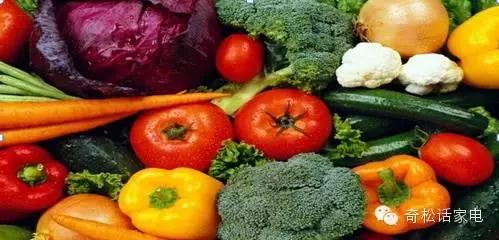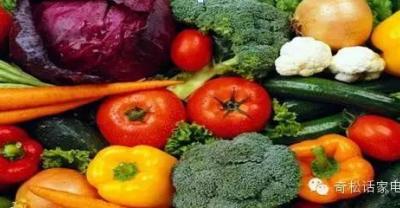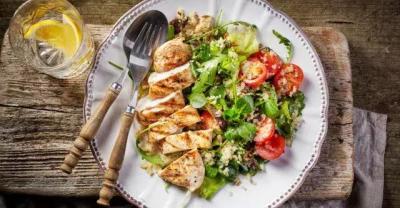What is the best storage temperature for fruits, vegetables and meat
Different vegetables and fruits have different producing areas, different nutrients and different storage temperatures. how can they be stored for a long time and less nutritional loss? Let's talk about this topic today!
I. the most suitable storage temperature for all kinds of vegetables and fruits
Most rhizome and leafy vegetables are suitable for storage near freezing point. Most vegetables and fruits originating in temperate and cold zones require a storage temperature of about 0 degrees, such as apples, pears, peaches, cauliflower, celery, etc.; most vegetables and fruits originating in the tropics and subtropics require temperatures above 0 degrees, such as 13 degrees for bananas, 10 degrees for mangoes, 12-13 degrees for cucumbers and 9-12 degrees for green peppers.
If the storage temperature is higher than the optimum temperature, it will accelerate the post-ripening and senescence process and shorten the storage period; if the storage temperature is lower than the optimum temperature, it will lead to chilling injury and freezing injury. The critical temperature of storage varies with different varieties.

Variety storage temperature ℃ storage time variety storage temperature ℃ storage time cucumber 8-101-2 weeks carrots 0-14-8 weeks melon 5-11-4 weeks carrots 0-11-4 weeks watermelon 10-12-3 weeks white radish 0-14-5 months pumpkin 10-132-5 weeks fennel 0-11-2 weeks towel gourd 5-81-3 weeks dried onions-16-8 months balsam pear 5-83-4 weeks garlic- 4 Mui 16-12 months wax gourd 101-3 weeks garlic bolts-16-10 months bergamot 74-6 weeks green onions 0-11-2 weeks east-west chicken 10-132-6 weeks ginger 134-6 months summer Xizhu 8-101-2 weeks mushrooms 07-10 days green tomatoes 12-151-2 weeks sweet corn 0-14-8 days red tomatoes 8-101 weeks tender potatoes 4-51-2 months eggplant 8-123-4 weeks old potatoes 4-54-9 Month green pepper 7-102-4 weeks Chinese cabbage 0-11-3 months green cabbage 0-13 months peas 0-11-3 weeks white cabbage 0-16-7 months green beans 7-81-2 weeks cauliflower 0-12-4 weeks broad beans 0-12-3 weeks celery 0-11-3 weeks green beans 2-42-3 weeks lettuce 0-42-4 weeks dried beans 0-12-4 weeks chicory 0-12-4 weeks beet head 0-13-8 weeks spinach 0-11-2 weeks
Vegetables that are not suitable for keeping in the refrigerator
Some vegetables put into the refrigerator, not only can not get the fresh-keeping effect, resulting in cell damage, vitamin C and other nutrients loss, and even more prone to corruption.
Beans stored in the refrigerator will affect the taste to a great extent, so they should be kept indoors without sunshine; pumpkins are suitable for storage above 10 ℃, but they will soon become soft and sticky in the refrigerator, resulting in the loss of their flavor; tomatoes are suitable for storage above 10 ℃, and they are prone to soft rot or cracking after cold storage, and the surface is prone to black spots, which will rot and rot for a long time.
Although these vegetables are best stored at room temperature, the humidity in the air at home is generally not very high, about 60%, which is very disadvantageous to store vegetables. So, even if you don't put them in the refrigerator, you still need to seal them with clean bags or put them in sealed containers to prevent the loss of moisture from vegetables.
2. The most suitable fresh-keeping temperature for fruit.
Suitable fresh-keeping temperature for different varieties Apple-1 ℃ ~ + 1 ℃ 85% Cold Storage temperature and humidity Storage 90% 2-7 days Pear-1 ℃ ~ + 1.5 ℃ 85% 90% 1-6 days Watermelon 2 ℃ ~ 4 ℃ 75% 7-10 days Cherry 0.5 ℃ ~ 1 ℃ 80% 7-21 days Coconut-4.5 ℃ ~-3 ℃ 75% 8-12 days Grape-1 ℃ ~ 3 ℃ 85% 90% 1-4 day strawberries-0.5 ℃ ~ 1.5 ℃ 75% 85% 7-10 days orange 0 ℃ ~ 1 ℃ 80% 90% 50-70 days pineapple 4 ℃ ~ 12 ℃ 85% 90% 14-20 days
Fruits that are not suitable for cold storage
Many fruits are not suitable for storage in the refrigerator, especially tropical fruits represented by mangoes, litchi and bananas. Mangoes are afraid of the cold. Once put in the refrigerator, black spots begin to appear within a few days; litchi will blacken and flesh will turn sour when placed in 0 ℃ for one day; bananas will easily blacken and rot and even cause mildew when placed in the environment below 12 ℃.
In addition to tropical fruits, persimmons and other berry fruits will fade in low temperature, and the skin will deteriorate.
Bananas and other tropical fruits are not suitable for cold storage.
Second, the most suitable fresh-keeping temperature for meat.
The best storage temperature and humidity of fresh meat in cold storage is 0 ℃ ~ 1 ℃ 80% 85% 8-10 days frozen meat-14 ℃ ~-18 ℃ 85% fresh meat 90% 15-30 days fresh fish-1 ℃ ~ 5 ℃ 90% 95% 7-10 days frozen fish-7 ℃ ~-10 ℃ 90% shrimp-7 ℃ ~-10 ℃ 80% eggs-1 ℃ ~ 1 ℃ 80% 90% 8-12 days
Meat is not suitable for storage after thawing
Frozen meat, frozen fish and other frozen due to the role of water crystallization, its cells have been destroyed, once thawed, the destroyed tissue cells will exudate a lot of nutrients, which will become the nourishment for bacterial reproduction.
Thawed meat should not be put in the refrigerator again.
Some experiments showed that the decay rate of frozen yellow croaker at 30 ℃ for 6 hours was twice as fast as that of fresh yellow croaker, and the number of bacteria increased about 2 times when the thawed yolk was placed at 18 ℃ for 2 hours. After 8 hours of storage, the number of bacteria increased by 50 times.
Nowadays, urban people are busy at work, and they usually have little time to go to the supermarket. Many people will choose to buy food for a week or even a month and store it in the refrigerator, only to find that a lot of food has rotted and cannot be eaten in a few days, causing a lot of waste. Therefore, do not mistakenly think that it is all right to put the bought food in the refrigerator, and it is good to know some general knowledge of food preservation.
Below, the author to introduce to you the use of refrigerators should pay attention to some of the most operational matters, these matters are relatively easy for consumers to make mistakes. By comparison, have you made all these mistakes?
III. Six forbidden areas for storing food in refrigerators
1. Hot food should never be put in a running refrigerator, because if the temperature sensor in the refrigerator senses the temperature of the hot food, the refrigerator will keep running, which will not only cost electricity, but also affect the refrigerating effect of other foods.
two。 Refrigerator storage of food should not be too full, too tight, to leave a gap, so that cold air convection. Whether it is a direct-cooled or air-cooled refrigerator, if there is no hot and cold air for heat exchange, the refrigerator may never stop, which will not only waste electricity, but also affect the service life of the refrigerator.
3. The refrigerator must be defrosted regularly, because the existence of the frost layer will affect the transmission efficiency of cold energy, and the refrigerator can not reach the set temperature. In this way, it will bring a lot of load to the refrigerator. In order to prevent the frosting speed inside the refrigerator, the editor suggested that all the food in the freezer should be covered with fresh bags to prevent moisture evaporation and frosting.
4. Thawed meat and fish should be eaten as soon as possible and should not be stored in the refrigerator again. If it is stored again, the activity of bacteria and enzymes in meat and fish will be restored, which may produce toxic histamine substances and bring food safety risks.
5. Do not put bottled liquid drinks in the freezer so as not to crack the bottles. It should be stored in the cold room, and the best storage temperature is about 4 ℃.
6. The refrigerator fresh-keeping box is very good for food preservation, and the leftover food must be put into the fresh-keeping box before it can be stored in the refrigerator, otherwise it is easy to deteriorate and cause cross-contamination.
If conditions permit, it is best to pick and eat now or buy and eat now.
Author Qisong dialect Home Appliances
-END
- Prev

Eating six kinds of vegetables can reduce blood fat
High blood fat, high cholesterol, hypertension, high blood sugar, fatty liver is now an epidemic disease, lowering blood fat and blood pressure has become a hot topic. How to Get Rid of...
- Next

It turned out to be number one on the list of slimming vegetables!
Vegetables are the healthiest green food, it contains fewer calories, nutrition is conducive to weight loss, then what vegetables to eat the fastest weight loss? See if you made the right choice? ...
Related
- Where is it suitable to grow horseradish in China? it is expected to see the middle altitude horseradish in Alishan.
- How to prevent tomato virus disease reasonably? (Control methods included)
- Many people like to plant towel gourd on the balcony. What are the main points of this method and management?
- What crops can chili peppers be mixed with?
- Fertilization techniques and matters needing attention in Tomato
- What are the grafting techniques for peach seedlings in spring?
- Harm and control methods of root swelling disease of Chinese cabbage
- What are the pests of sweet potatoes? How to prevent and cure it?
- Symptoms, causes and Control methods of navel Rot in Tomato
- The cause of "Cucumber rotten bibcock" in Farmers' planting Cucumber and its Control Plan

